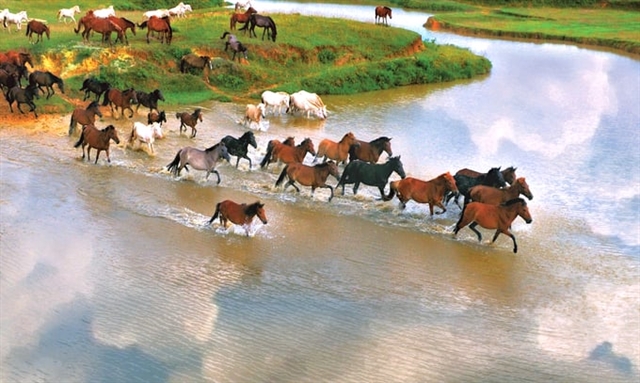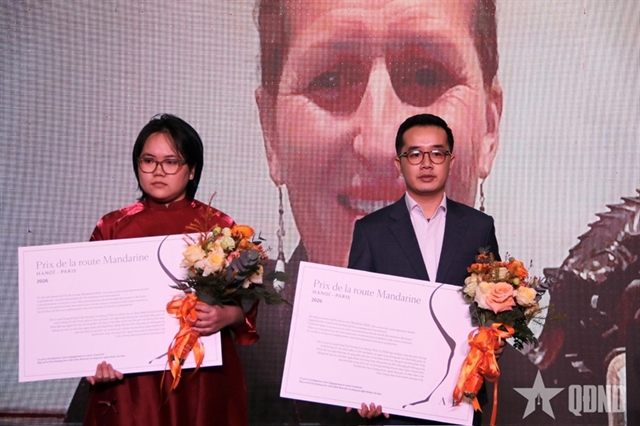 Society
Society

 |
| Horses galloping at Bá Vân Hill. Photo nongnghiep.vn |
THÁI NGUYÊN The Bá Vân Horse Breeding Farm, now the Mountain Livestock Research and Development Centre in Bình Sơn commune, Sông Công City, Thái Nguyên Province was established in April 1960 to research and transfer horse breeding techniques to serve the lives and production of ethnic communities in the northern mountainous region.
Since its establishment, the centre has faced numerous challenges and hardships, mirroring the difficulties of the nation. Researching unique livestock for the mountainous region and being located in areas with challenging economic, social and transportation conditions, the centre has significantly contributed to the development of agriculture and rural areas in general, particularly in horse and buffalo breeding in the mountainous regions.
Today the Mountain Livestock Research and Development Centre is known as the institution that researches and preserves the largest gene pool of horses and buffalo in the country. With its predecessor being the Bá Vân Horse Breeding Farm, the centre has accumulated many years of experience in researching and developing horse breeds in Việt Nam.
In the past, horses were closely linked with the daily lives of people in the northern mountainous ethnic communities. Horses served as transportation, cargo carriers, and draught animals for ploughing fields and pulling carts. There was a significant demand for various horse breeds to meet the needs of people's livelihoods.
Notably, the border guard forces in provinces like Điện Biên, Hà Giang and Cao Bằng still ride horses when patrolling and guarding along the border. And although transportation has become more convenient and modern, especially in border areas with challenging terrain, horses remain valuable assets for the people in mountainous regions.
The enthusiastic engineer
From the beginning, the work of the Mountain Livestock Research and Development Centre on the process of raising and caring for horses for the people was quite challenging.
Most households breeding horses lived in remote areas with difficult transportation, lacking electricity and basic facilities. In some areas, the only way to reach them was by walking. During those times, every business trip by the centre's staff was calculated in weeks, sometimes even months.
Recalling those challenging days, Tạ Văn Cần, Deputy Director of the Mountain Livestock Research and Development Centre, at that time a young engineer fresh out of university, embarked on these journeys with determination.
Starting his work at the centre in 1998, the young engineer carried the flame of enthusiasm and the vigour of youth, setting out on monthly business trips to share techniques and experiences in caring for livestock with people in remote highland areas.
Cần shared with the Vietnam Agriculture newspaper about a memorable business trip to Trung Khánh District, Cao Bằng Province, in 2000. He was sent by the centre to assist in caring for sick horses.
Ironically, when he was studying livestock veterinary medicine at the University of Agriculture III (now Thai Nguyen University of Agriculture and Forestry), the young engineer had not received any training on horses. For the young officer, all the experience and knowledge he had were from books, while for the local people, horses were valuable and extremely precious assets.
The young engineer couldn't escape anxiety, so before setting out he had to read extensively to understand more about horses and to be able to convey that knowledge and experience to the people, especially the folk experiences and small tips for treating horses.
"At that time, I encountered a case of a sick horse with abdominal pain. It was the first time I had come into contact with and had to control a grown horse. I was nervous and worried because a grown horse is very strong, and if I didn't know how to control it, I wouldn't be able to hold it," Cần recalled.
Applying the knowledge he had gained, the young engineer managed to control the horse more easily for care. At the same time, he shared those experiences with the local people. First, to control a horse, you have to lift one of its legs. The horse will lose balance and stand still. Second, you have to tighten the lips of the horse to control it because that is the area with many nerve endings. With these two steps, the horse will stand still, allowing the owner to take care of its health.
In this way, the young Cần practised and instructed the local people. Although the work proceeded quite smoothly, he could only breathe a sigh of relief two days later. At that time, the host was very happy and excited because if they didn't know how, controlling a horse would become very difficult, even requiring tying the horse up, which is not a simple task.
"At that time, if the people were happy, I was ten times happier because I felt that the knowledge I had learned could be applied in practice. My work could help the people. Moreover, in the role of a representative of the centre seen as the cradle of the Bá Vân horse farm, I felt proud not only for myself but also for the unit because the stature of the Bá Vân horse farm in the eyes of the people had been raised. Although the work was tough, I was rewarded with the sincere, affectionate trust of the people," Cần said emotionally.
More than 20 years have passed since that memorable business trip, but in the eyes of the leader of the Mountain Livestock Research and Development Centre, the memory remains vivid and emotionally charged. It seems that the flame of passion and love for the profession of the young engineer from the past is still burning fiercely in his heart. VNS




